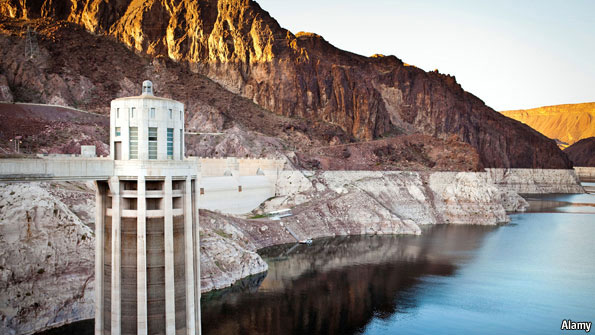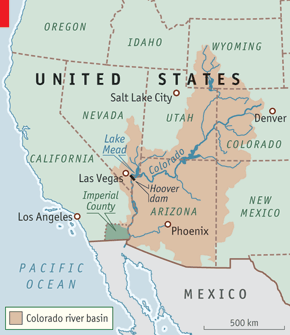The Colorado River and the civilisation it waters are in crisis
UNITED STATES
Water worries
The drying of the West
Jan 27th 2011 | HOOVER DAM
From The Economist print edition

STANDING on the Hoover Dam and looking upstream at Lake Mead, America’s largest reservoir, the visitor notices a wide, white band ringing the cliffs. Nicknamed “the bathtub ring”, this discolouration comes from minerals that were once deposited on the volcanic rock by the Colorado River and have become visible as its level has dropped. It is one sign of a water crisis that threatens America’s south-west.
Other reminders abound. Farther upstream there are dry docks, jutting out ominously into desert, where boats were once moored. In one finger of Lake Mead buildings that were abandoned in the 1930s, as the water of the newly dammed river rose and submerged them, have eerily begun reappearing, like a ghost town.
The main reason why Lake Mead, currently only 40% full, has been getting emptier is a decade-long drought. Whether this is a cyclical and normal event, or an early sign of climate change, is unclear. But even if the drought ends, most scientists think global warming will cause flows on the Colorado River to decrease by 10-30% in the next half century, says Douglas Kenney, the director of a water-policy programme at the University of Colorado Law School.
The other reason, says Mr Kenney, is the rapidly increasing demand for the river’s water. The Colorado provides much or most of the water for many cities and farms in seven states—Colorado, Wyoming, Utah, New Mexico, Nevada, Arizona and California—before it peters out in the sands of Mexico.
In the northern states, its water supports cattle empires. In its southern stretch, especially in California’s Imperial County, the river irrigates deserts to produce America’s winter vegetables. And all along the way, aqueducts branch off to supply cities from Salt Lake City and Denver to Phoenix and Los Angeles. The metropolis closest to Lake Mead, Las Vegas, gets 90% of its water from this one source.

That is why Las Vegas is a canary in the mine shaft, as Pat Mulroy, the boss of the Southern Nevada Water Authority, puts it. The Las Vegas valley gets its water through two long channels drilled through the rock. The first taps the lake at 1,050 feet (320 metres) above sea level, the second at 1,000 feet. Lake Mead’s water level is now near its record low, at 1,086 feet. Within a few years it could leave Las Vegas’s first intake, or even both, dry.
The threat to Sin City is a good example of the four dimensions—physical, legal, political and cultural—of water in the West. For the physical, the standard response is to summon the engineers. Ms Mulroy already has them digging a third intake at 890 feet. Given the weight of the water on top, this is fiendishly difficult and will not be ready until 2014. Ms Mulroy also wants to pipe groundwater from the rural and wetter northern counties of Nevada to Las Vegas, but that has caused a vicious row.
Another response is to call in the lawyers. This was the preferred approach a century ago, in the era of the “water wars”. Starting with the Colorado River Compact of 1922 and continuing with statutes, a treaty with Mexico and case law until the 1960s, a truce was achieved. Called the Law of the River, the resulting regime determines who along the river has what right to how much water.
At least, it does in theory. The problem is that the law took shape after two decades of record water flows, which became the basis for allocation. As a result it apportions more water than there is in the river. For decades that did not matter, since there were so few people. Then the cattle, fruit and people using the river multiplied.
The law’s seniority rules theoretically mean that, for example, the taps to Las Vegas would be shut completely before a single lettuce-grower in California’s Imperial County lost a drop. This “idiocy of who gets cut first and second”, as Ms Mulroy calls it, gives rise to the political dimension. These days, co-operation has supplemented, if not wholly replaced, the old rivalries among agricultural and urban users, and among the seven states. Nevada and Arizona, for example, have a water-banking partnership, whereby Arizona stores excess water in its aquifers so that Nevada could use it in a pinch. In California, the water utility of Los Angeles has bought water rights from farmers in Imperial County. But arguments persist.
The final dimension is the culture of the West. Does every middle-class house really need a lawn in a desert? Ms Mulroy has already started paying Las Vegans to rip out their turf and opt for desert landscaping, which can be chic. Her own husband put up a fight but lost. So out went that lawn, too, just as the low-flow toilets and taps came in.
Copyright © 2011 The Economist Newspaper and The Economist Group. All rights reserved.
